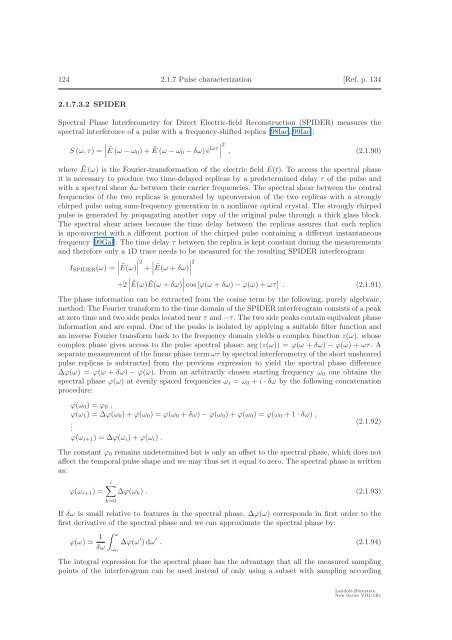2.1 Ultrafast solid-state lasers - ETH - the Keller Group
2.1 Ultrafast solid-state lasers - ETH - the Keller Group
2.1 Ultrafast solid-state lasers - ETH - the Keller Group
Create successful ePaper yourself
Turn your PDF publications into a flip-book with our unique Google optimized e-Paper software.
124 <strong>2.1</strong>.7 Pulse characterization [Ref. p. 134<br />
<strong>2.1</strong>.7.3.2 SPIDER<br />
Spectral Phase Interferometry for Direct Electric-field Reconstruction (SPIDER) measures <strong>the</strong><br />
spectral interference of a pulse with a frequency-shifted replica [98Iac, 99Iac]:<br />
∣<br />
∣<br />
S (ω, τ) = ∣Ẽ (ω − ω 0)+Ẽ (ω − ω 0 − δω)e iωτ ∣∣<br />
2<br />
, (<strong>2.1</strong>.90)<br />
where Ẽ (ω) is <strong>the</strong> Fourier-transformation of <strong>the</strong> electric field E(t). To access <strong>the</strong> spectral phase<br />
it is necessary to produce two time-delayed replicas by a predetermined delay τ of <strong>the</strong> pulse and<br />
with a spectral shear δω between <strong>the</strong>ir carrier frequencies. The spectral shear between <strong>the</strong> central<br />
frequencies of <strong>the</strong> two replicas is generated by upconversion of <strong>the</strong> two replicas with a strongly<br />
chirped pulse using sum-frequency generation in a nonlinear optical crystal. The strongly chirped<br />
pulse is generated by propagating ano<strong>the</strong>r copy of <strong>the</strong> original pulse through a thick glass block.<br />
The spectral shear arises because <strong>the</strong> time delay between <strong>the</strong> replicas assures that each replica<br />
is upconverted with a different portion of <strong>the</strong> chirped pulse containing a different instantaneous<br />
frequency [99Gal]. The time delay τ between <strong>the</strong> replica is kept constant during <strong>the</strong> measurements<br />
and <strong>the</strong>refore only a 1D trace needs to be measured for <strong>the</strong> resulting SPIDER interferogram<br />
∣<br />
∣ ∣∣<br />
I SPIDER (ω) = ∣Ẽ(ω) 2 ∣ ∣∣ + Ẽ(ω + δω) ∣ 2<br />
∣<br />
∣<br />
∣∣<br />
+2 ∣Ẽ(ω)Ẽ(ω + δω) cos [ϕ(ω + δω) − ϕ(ω)+ωτ] . (<strong>2.1</strong>.91)<br />
The phase information can be extracted from <strong>the</strong> cosine term by <strong>the</strong> following, purely algebraic,<br />
method: The Fourier transform to <strong>the</strong> time domain of <strong>the</strong> SPIDER interferogram consists of a peak<br />
at zero time and two side peaks located near τ and −τ. The two side peaks contain equivalent phase<br />
information and are equal. One of <strong>the</strong> peaks is isolated by applying a suitable filter function and<br />
an inverse Fourier transform back to <strong>the</strong> frequency domain yields a complex function z(ω), whose<br />
complex phase gives access to <strong>the</strong> pulse spectral phase: arg (z(ω)) = ϕ(ω + δω) − ϕ(ω) +ωτ. A<br />
separate measurement of <strong>the</strong> linear phase term ωτ by spectral interferometry of <strong>the</strong> short unsheared<br />
pulse replicas is subtracted from <strong>the</strong> previous expression to yield <strong>the</strong> spectral phase difference<br />
Δϕ(ω) =ϕ(ω + δω) − ϕ(ω). From an arbitrarily chosen starting frequency ω 0 one obtains <strong>the</strong><br />
spectral phase ϕ(ω) at evenly spaced frequencies ω i = ω 0 + i · δω by <strong>the</strong> following concatenation<br />
procedure:<br />
ϕ(ω 0 )=ϕ 0 ,<br />
ϕ(ω 1 )=Δϕ(ω 0 )+ϕ(ω 0 )=ϕ(ω 0 + δω) − ϕ(ω 0 )+ϕ(ω 0 )=ϕ(ω 0 +1· δω) ,<br />
.<br />
ϕ(ω i+1 )=Δϕ(ω i )+ϕ(ω i ) .<br />
(<strong>2.1</strong>.92)<br />
The constant ϕ 0 remains undetermined but is only an offset to <strong>the</strong> spectral phase, which does not<br />
affect <strong>the</strong> temporal pulse shape and we may thus set it equal to zero. The spectral phase is written<br />
as:<br />
ϕ(ω i+1 )=<br />
i∑<br />
Δϕ(ω k ) . (<strong>2.1</strong>.93)<br />
k=0<br />
If δω is small relative to features in <strong>the</strong> spectral phase, Δϕ(ω) corresponds in first order to <strong>the</strong><br />
first derivative of <strong>the</strong> spectral phase and we can approximate <strong>the</strong> spectral phase by:<br />
ϕ(ω) ≃ 1 ∫ ω<br />
Δϕ(ω ′ )dω ′ . (<strong>2.1</strong>.94)<br />
δω ω 0<br />
The integral expression for <strong>the</strong> spectral phase has <strong>the</strong> advantage that all <strong>the</strong> measured sampling<br />
points of <strong>the</strong> interferogram can be used instead of only using a subset with sampling according<br />
Landolt-Börnstein<br />
New Series VIII/1B1
















